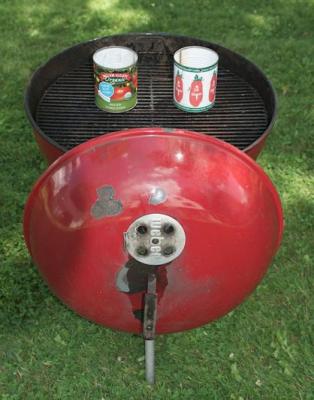Don't Barbecue - Char-BQ
- Log in to post comments
See the all new 2012 instructions attached:
http://www.biochar.bioenergylists.org/files/ican_weber_conversion.pdf
Jock Gill, It's Summer!
See the attached pdf file for printable Char-B-Que Instructions in Gorgeous Full Color Detail!
Basic Elements -- these are the elements required to convert a Weber unit to a carbon
negative Char-B-Que.
The B stands for Biochar. Total cost: $0.00
two cans -- these will be turned into iCan TLUD stove units
For more pictures of other experiments: http://www.flickr.com/photos/jockgill/
Hint: Measure the circumference of the can. Divide that by the number of holes you
want to have in your design. Use that result as the distance between hole centers.
Mark the hole centers as per the above and then make your holes.
Hint: Always make small pilot hole first and then work your way up to bigger and bigger
holes made with larger and larger tools. A set of graduated nails and spikes works
great. When in doubt, start with fewer and smaller holes. In general, primary air holes
will be smaller and secondary air holes will be much larger. The number of holes you
use and their sizes, and locations, has to be tuned for draft conditions, fuel type, fuel
form factor, and fuel size.
Perfect Char-B-Que Chicken. Juicy. Tender. No smokey taste. And no burned bits at all.Skin was also very crispy.
Cooking time: about 45 minutes. The right iCan had more primary air holes, 21, and burned out at 40 minutes.
The left iCan was complete at 48 minutes. It had only 15 holes for primary air. Tuning is important.
Biochar from the wood pellets in the iCan TLUDs at the end of the Char-B-Que. The biochar, which will be mixed with compost and then added to gardens as a soil amendment is how carbon that was in the wood pellets is sequestered. The long term sequestering of the carbon from the biomass is what makes the Char-B-Que "Carbon Negative".
affiliate tracking url | Nike Shoes

